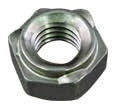The answer to this will be weld nut manufacturing methods, cost, and final product design requirements. Nuts are generally formed with three to six projections on the one side. More projections would be used for higher strength applications. The shape of these projections also varies from points to rounded with various heights. The material being welded may also dictate the projection style and weld schedule speed or need for tempering if working with high strength steels. Nut manufacturing cost and final desired nut welded strength determine which style will be best for your application. Pointed and round projections will both make good projection welds. The question is which style and how many projections will be the most consistent in size, shape and final welded strength for your application.




Three Projection Hex Nut Six Projection Hex Nut Three Projection Round Nut Ring Projection on Stud
The ring projection shown is used to maximize joint strength or to form an hermetic seal. This might be used in heating and air conditioning or hydraulics equipment. The center ring on the other three parts is used as a locator/alignment aid.
Consistency in your projections, along with good equipment alignment, fast follow up and proper processes will lead to good projection weld quality. The actual projection design is a decision to be made based on the data from your nut supplier and your end part requirements.
Reference: RWMA Manual- Chapter 3, Projection Welding

